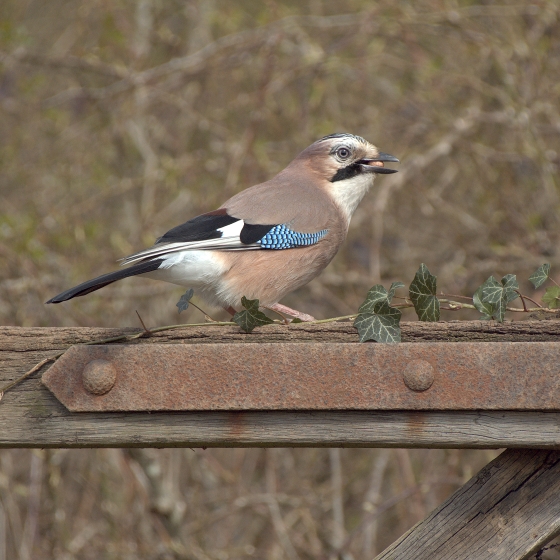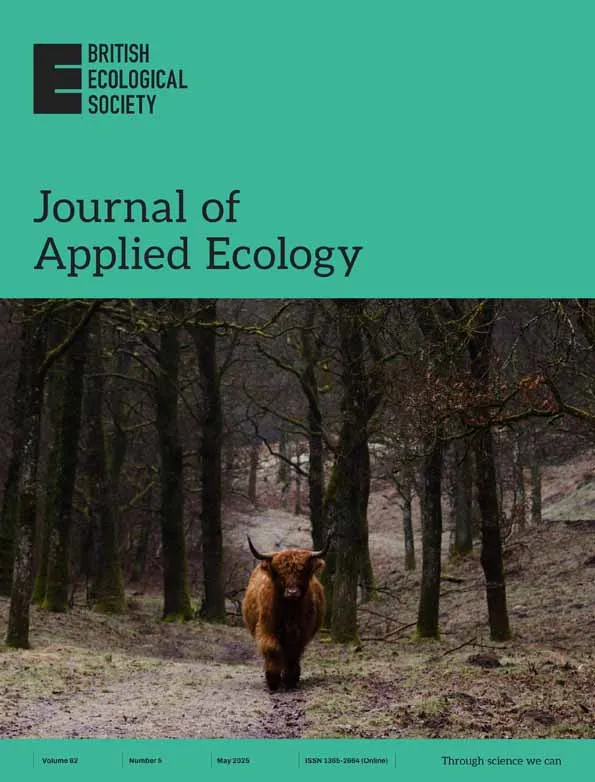Jay

Introduction
A very colourful member of the crow family, Jays are often mistaken for something more exotic from warmer climes.
The pinkish plumage and striking blue and black barring on the wing make the Jay stand out from its neighbours. It has a bounding flight where its white rump is an easily noticed feature. Landing in a tree, the bird swoops up to a branch and then sits tight making it surprisingly hard to see when perched. Its raspy call can be the best indicator of its presence.
The Bird Atlas 2007-11 suggests that Jay distribution is constrained by woodland cover and climate. Recent surveys have shown the range of this species to be expanding to the north and west, particularly in Scotland and Ireland, although the fluctuating population numbers show no real trend up or down.
- Our Trends Explorer gives you the latest insight into how this species' population is changing.

Key Stats
Identification
Songs and Calls
Song:
Call:
Alarm call:
Status and Trends
Conservation Status
Population Change
The UK Jay population remained stable in the species' preferred woodland habitat until the late 1980s, after which the population began to decline. This decrease followed an earlier decline on farmland CBC plots (Gregory & Marchant 1996). With the losses since the 1980s now regained, long-term trends are stable overall. The BBS map of change in relative density between 1994-96 and 2007-09 indicates that increases occurred almost everywhere during this period, with the exception of parts of central southern England. Mean brood size appears to have increased by half a chick since 1968, and nest success has also improved, so the number of fledglings per breeding attempt has increased, though all demographic measures are based on small samples. There has been an increase across Europe since 1980 (PECBMS: PECBMS 2020a>).
Distribution
Jay distribution within Britain & Ireland is thought to be constrained by woodland cover and climatic conditions.
Occupied 10-km squares in UK
2007/08–10/11
or view it on Bird Atlas Mapstore.
2008–11
or view it on Bird Atlas Mapstore.
European Distribution Map
Distribution Change
Jay's winter distribution has expanded since the 1981–84 Winter Atlas, with an 86% range expansion in Ireland and a 16% expansion in Britain, where there have been major gains in Scotland.
Change in occupied 10-km squares in the UK
from 1981–84 to 2007–11
or view it on Bird Atlas Mapstore.
from 1968–72 to 2008–11
or view it on Bird Atlas Mapstore.
Seasonality
Jay is recorded throughout the year but detections peak in autumn when birds disperse or are actively seen caching food for the winter.
Weekly pattern of occurrence
The graph shows when the species is present in the UK, with taller bars indicating a higher likelihood of encountering the species in appropriate regions and habitats.

Habitats
Breeding season habitats
Relative frequency by habitat
The graph shows the habitats occupied in the breeding season, with the most utilised habitats shown at the top. Bars of similar size indicate the species is equally likely to be recorded in those habitats.

Movement
Britain & Ireland movement
Foreign locations of birds ringed or recovered in Britain & Ireland
Dots show the foreign destinations of birds ringed in Britain & Ireland, and the origins of birds ringed overseas that were subsequently recaptured, resighted or found dead in Britain & Ireland. Dot colours indicate the time of year that the species was present at the location.
- Winter (Nov-Feb)
- Spring (Mar-Apr)
- Summer (May-Jul)
- Autumn (Aug-Oct)

European movements
EuroBirdPortal uses birdwatcher's records, such as those logged in BirdTrack to map the flows of birds as they arrive and depart Europe. See maps for this species here.
The Eurasian-African Migration Atlas shows movements of individual birds ringed or recovered in Europe. See maps for this species here.
Biology
Productivity and Nesting
Nesting timing
Egg measurements
Clutch Size
Incubation
Fledging
Survival and Longevity
Survival is shown as the proportion of birds surviving from one year to the next and is derived from bird ringing data. It can also be used to estimate how long birds typically live.
View number ringed each year in the Online Ringing Report.
Lifespan
Survival of adults
Survival of juveniles
Biometrics
Wing length and body weights are from live birds (source).
Wing length
Body weight
Ring Size
Classification, names and codes
Classification and Codes
- Order: Passeriformes
- Family: Corvidae
- Scientific name: Garrulus glandarius
- Authority: Linnaeus, 1758
- BTO 2-letter code: J.
- BTO 5-letter code: JAY..
- Euring code number: 15390
Alternate species names
- Catalan: gaig eurasiàtic
- Czech: sojka obecná
- Danish: Skovskade
- Dutch: Gaai
- Estonian: pasknäär
- Finnish: närhi
- French: Geai des chênes
- Gaelic: Sgreuchag-choille
- German: Eichelhäher
- Hungarian: szajkó
- Icelandic: Skrækskaði
- Irish: Scréachóg
- Italian: Ghiandaia
- Latvian: silis, krekis
- Lithuanian: eurazinis kekštas
- Norwegian: Nøtteskrike
- Polish: sójka (zwyczajna)
- Portuguese: gaio
- Slovak: sojka obycajná
- Slovenian: šoja
- Spanish: Arrendajo euroasiático
- Swedish: nötskrika
- Welsh: Sgrech y Coed
- English folkname(s): Acorn Jay
Research
Causes of Change and Solutions
Causes of change
There is little good evidence available regarding the drivers of the breeding population change in this species in the UK.
Further information on causes of change
No further information is available.
Information about conservation actions
The UK population of the Jay has been stable over the long-term and has increased over the last 25 years, hence it is not a species of concern and no conservation actions are currently required.
The drivers of change are not known and no specific conservation actions have been proposed for this species, although actions to maintain and restore woodland habitats to benefit declining woodland specialists may also benefit generalists including the Jay.
Publications (3)
Identity of predators of bird nests in the British Islands
Author: Barton, M.G., Conway, G.J., Henderson, I.G., Baddams, J., Balchin, C.S., Brides, K., Butcher, N., Cameron, T.C., Davis, T., Eyre, J., Foster, R., Gornall, D., Karipal Kallamballi, N., Laurie, P., Nixon, A., Noyes, P., Parish, D.M.B., Samson, L., Smart, J., Wilde, N., Wright, M.A. & Dolman, P.M.
Published: 2025
Nest cameras identify predators of wild birds’ nests in Britain and Ireland.
21.08.25
Papers

Associations between gamebird releases and general predators
Author: Pringle, H., Wilson, M., Calladine, J. & Siriwardena, G.M.
Published: 2019
BTO research reveals that the release of Pheasants and Red-legged Partridges for commercial shoots may be boosting numbers of the avian predators and scavengers. Every year, 41-50 million non-native gamebirds (Pheasant and Red-legged Partridge) are released in the UK. Fewer than half these birds are shot, meaning there is potentially a large food resource available to predators and scavengers, sustaining their populations above the levels they would otherwise reach. If it occurs, this inflation of predator numbers might alter predator-prey dynamics, increasing predation pressure on some vulnerable species, including declining breeding waders like Curlew. This study used data from the Breeding Bird Survey and Bird Atlas 2007-11 to identify associations between the occurrence patterns of gamebirds and the abundance and population growth rates of several generalist predators, including Buzzard, Jay, Raven, Magpie and crows (Carrion and Hooded combined). While many other factors influence predator abundance, such as fine-scale habitat variation, availability of other food sources, and game management activities, the results suggest that large-scale variation in avian predator populations is predominantly positively affected by gamebird releases. The potential implications of this finding need to be thoroughly tested. Such tests could include regulation of releases on a trial basis, to determine effects on ground nesting birds, for example. The compulsory recording of releases and the number of predators controlled would also be valuable for a better understanding of the impacts, positive or negative, of gamebird releases on the wider environment. Read a blog post by publication author Henrietta Pringle discussing the work behind this paper.
02.07.19
Papers

Incorporating fine-scale environmental heterogeneity into broad-extent models
Author: Graham, L.J., Spake, R., Gillings, S., Watts, K. & Eigenbrod, F.
Published: 2019
08.04.19
Papers
More Evidence
More evidence from Conservation Evidence.com
Partners
Citing BirdFacts
If you wish to cite particular content in this page (e.g. a specific value) it is best to use the original sources as linked in the page. For a more general citation of the whole page please use: BTO (20XX) BirdFacts Species: profiles of birds occurring in the United Kingdom. BTO, Thetford (www.bto.org/birdfacts, accessed on xx/xx/xxxx).

